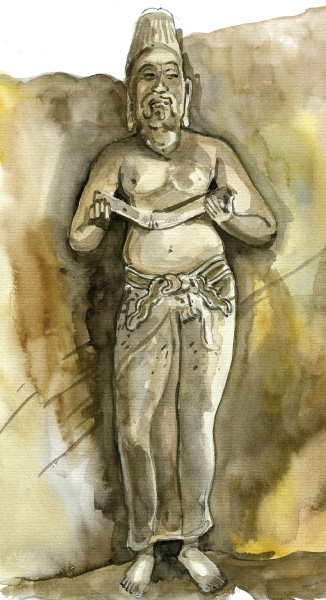Parakramabahu the Great
by Husna Inayathullah
"Not even a little water that comes from the rain must flow into the
ocean without being made useful to man" -Parakramabahu I
King Parakramabahu I was born in 1123 and ruled Sri Lanka from 1153
to 1186.During his reign from his capital Polonnaruwa, he unified the
three sub kingdoms of the island, becoming one of the last monarchs in
Sri Lankan history to do so.
 |
|
The stone statue in Polonnaruwa beleived
to be of Parakramabahu the Great. |
He oversaw the expansion and beautification of his capital,
constructed extensive irrigation systems, reorganised the country's
army, reformed Buddhist practices, encouraged the arts and undertook
military campaigns in southern India and in Myanmar.
The adage "not even a little water that comes from the rain must flow
into the ocean without being made useful to man" is one of his most
famous utterances.
Parakramabahu spent much of his youth in the courts of his uncles
Kitti Sri Megha and Sri Vallabha, the kings of the principalities of
Dakkhinadesa and Ruhuna respectively, as well as in the court of the
King of Rajarata,Gajabahu II. He succeeded his uncle Kitti as king of
Dakkhinadesa around 1140 and over the next decade improved
Dakkhinadesa's infrastructure and military.
Civil War
Following a protracted civil war, he secured power over the entire
island around 1153 and remained in this position until his death in1186.
During Parakramabahu's reign, he launched a punitive campaign against
the kings of Myanmar,aided the Pandyans against the Chola Empire in
southern India and maintained extensive trade relations with China and
countries in the Middle East. Within the island, he consecrated
religious monuments, built hospitals, social welfare units, canals and
large reservoirs, such as the Sea of Parakrama.
According to the ancient chronicle Culavamsa, Parakramabahu's birth
was predicted by a figure akin to a god seen in a dream by his father,
King Manabharana of Dakkhinadesa. A son was duly born to Manabharana's
wife Ratnavali, and was named Parakramabahu because of his "foe-crushing
arms".
Though the year of his birth has not been confirmed, it is generally
thought to be around 1123. The location would almost certainly have been
the capital of Dakkhinadesa, Punkhagama.
Upon being informed of the child's birth, Vikramabahu I in
Polonnaruwa ordered that the boy be brought up as the heir to his
throne. This kind of adoption may have been an olive branch of sorts on
the part of Vikramabahu who wished to keep the throne until his death,
after which it would be passed on to Parakramabahu.
Jewel
Manabharana, however, rejected the offer, stating that "It is not
(prudent) .... to send away such a jewel of a son". He also speculated
that "...if the boy is taken thither, the party of Vikkamabahu... will
gleam with mighty, up-shooting flames, but our misfortune, alas so
great, will become still worse!"
The division that existed between the royal clans of Sri Lanka was
too deep to allow for this manner of accommodation.
Soon after the child's birth, Manabharana fell ill and died. His
younger brother Kitti Sri Megha who was joint king of Ruhuna ascended
the throne of Dakkhinadesa, while Sri Vallabha was declared sole king of
Ruhuna. Parakramabahu, his mother Ratnavali and his two sisters Mitta
and Pabhavati, were sent to live in Mahanagahula, the capital of Ruhuna
under the care of Sri Vallabha.
The politics of Sri Lanka inevitably played a significant role in
Parakramabahu's upbringing. While he was still young, his eldest sister
Mitta was forcibly married to their cousin, Manabharana, the son of Sri
Vallabha of Ruhuna against the wishes of Queen Ratnavali.
Ratnavali was herself of the Kalinga clan of the royal family.Though
she was the widow of a king of the Arya branch of the royal family, she
preferred to see her daughters married to a king from the Kalinga clan.
During his time at Sri Vallabha's court, Parakramabahu met his future
Queen Lilavati, Sri Vallabha's daughter who following Parakramabahu's
death went on to rule the country in her own right.
In 1132, following the death of Vikramabahu, Gajabahu II succeeded to
the throne of Rajarata. Taking advantage of the new king's youth, the
two monarchs of the Arya branch of the Royal family, Sri Vallabha and
Kitti Sri Megha, tried unsuccessfully to seize Rajarata by force.
Gajabahu established himself firmly as ruler and therefore nominally
senior to the two Arya kings and neither Sri Vallabha nor Kitti Sri
Megha would live to see the king of Rajarata dethroned.
Capital
After the end of the Arya-Kalinga civil war, Parakramabahu left Sri
Vallabha's palace in Ruhuna and returned to Sankhatthali, the new
capital of Dakkhinadesa, where he took up residence with his uncle.The
Culavamsa attributes the departure to his impatience and lack of
stimulation in Ruhuna. It may also have been caused by Sri Vallabha's
plans to place Manabharana of Ruhuna on the throne of Rajarata which
made Parakramabahu's position increasingly precarious in court.In
Dakkhinadesa, on the other hand, he was well received by Kitti Sri Megha,
who had no sons of his own, where he was essentially adopted. The
Culavamsa thereafter refers to Kitti as Parakramabahu's father. During
his time at Dakkhinadesa, he studied important works of Kautilya and
subjects such as grammar, literature,elephant-riding, martial arts, song
and dance.
To be continued... |

